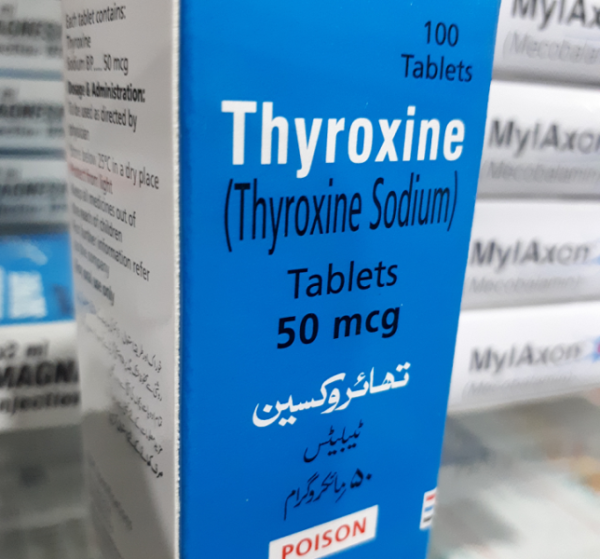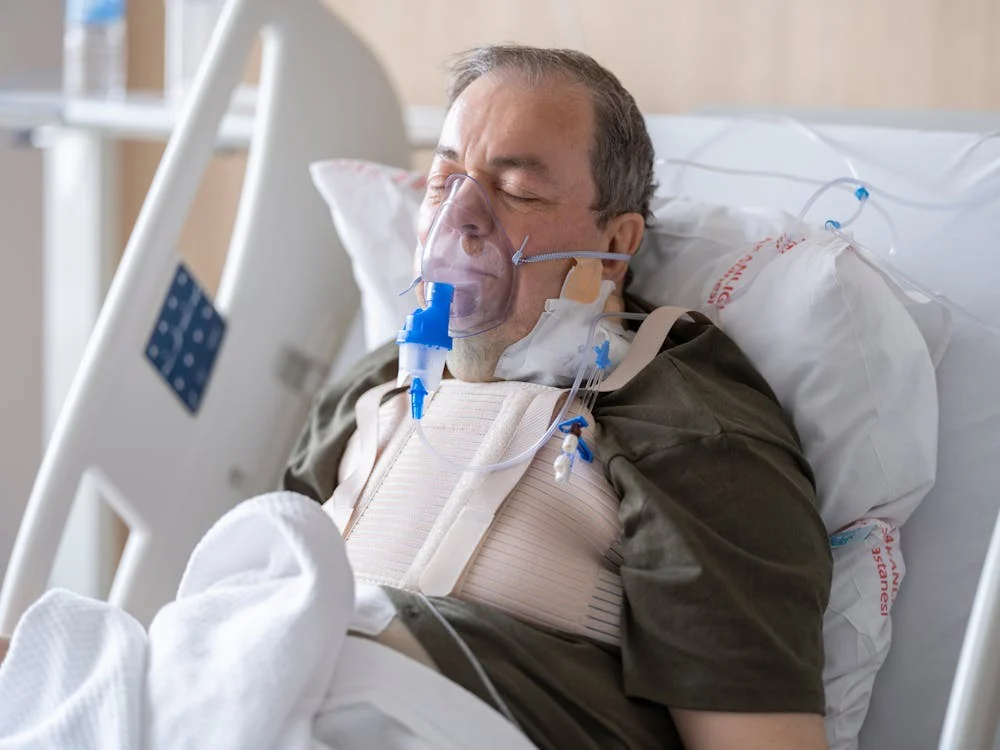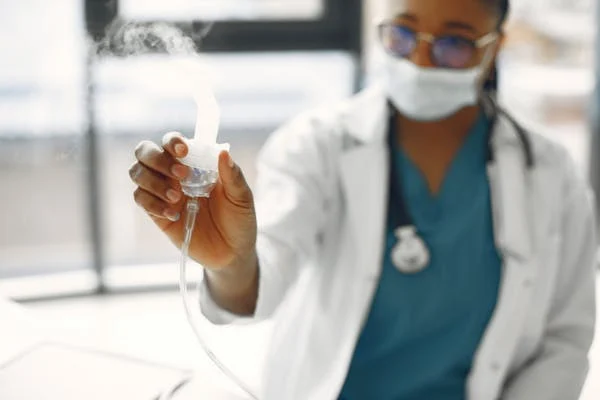Levothyroxine (Eltroxin, Thyroxine) is an essential hormone required by the body for almost every function. Thyroxine is normally synthesized in the thyroid gland. Certain conditions can result in hypothyroidism that may necessitate the exogenous intake of thyroxine.
Levothyroxine uses:
- Primary hypothyroidism treatment (a condition in which the thyroid gland is not functional)
- the management of central or secondary hypothyroidism (in which the pituitary gland or the hypothalamus is not producing the thyroid-stimulating hormone and thyrotropin-releasing hormone respectively).
- As a substitute for the lacking hormone and to inhibit the Thyroid Stimulating Hormone following surgery in thyroid cancer cases.
Can hypothyroidism go away? Can you stop taking thyroxine?
Hypothyroidism usually does not go away by itself. Symptoms of hypothyroidism improve with levothyroxine after 2 - 4 weeks. Levothyroxine and other thyroid preparations are usually taken life-long. Treatment should not be interrupted. Patients may require adjustment in the dose, however, non-compliance to therapy should be discouraged.
Levothyroxine and weight loss? Should you take it to lose weight?
People commonly take levothyroxine to lose weight. However, this trend should be strongly discouraged. The following are a few of the commonly searched google questions.
-
how to lose weight with thyroid medication
-
taking extra Synthroid to lose weight
-
best thyroid medication for weight loss
-
will I lose weight once I start taking thyroid medication?
It is important to note that when a hypothyroid patient takes levothyroxine, he/ she definitely loses some weight. This is because hypothyroidism results in weight gain and with levothyroxine replacement, the patient attains the actual weight by losing some. If a normal person takes levothyroxine, he is at risk of developing serious side effects including cardiac disease.
Levothyroxine should not be used for weight reduction (US Boxed Warning), because of serious cardiovascular adverse effects.
Contraindications to Levothyroxine
Patients with hypersensitivity to levothyroxine should not take Levothyroxine.
Patients with the following conditions are also advised not to take it:
- Hyperthyroidism (Thyrotoxicosis),
- Acute myocardial infarction (and
- Adrenal insufficiency (especially uncorrected adrenal insufficiency)
Cautions!!
- Patients with adrenal insufficiency should not take levothyroxine. Before starting levothyroxine, patients should first be on hydrocortisone.
- Patients with benign thyroid nodules should not be prescribed thyroxine for TSH suppression unless they are clinically and biochemically euthyroid.
- It should be taken slowly and checked for signs of hyperthyroidism.
- In these circumstances, the TSH level shouldn't be less than 0.1 mIU/L.
- Levothyroxine dosage for patients with heart disease, particularly angina, should not exceed a minimal quantity.
- Levothyroxine variations can have an impact on glycemic control.
- Patients who are elderly (>60 years), have systemic disorders or have osteoporosis should utilize thyroxine with caution.
Weight loss should not be achieved with levothyroxine(US Boxed Warning)Because of its serious adverse cardiovascular effects.
Dosage forms specific issues:
- Levoxyl (r): This product may quickly swell and dissolve causing choking, or gagging. It should be taken with a full glass of water.
- Patients with dysphagia and other swallowing problems should be cautious.
Levothyroxine Dose in Adults
Levothyroxine dose in Adults 18–49 years:
- The initial dose in adults is 50–100 micrograms once daily or 1.6 mcg/kg/day. Levothyroxine dose should be adjusted according to the response and TSH levels.
- The maintenance dose is rarely greater than 300 mcg/day.
- Patients who require a thyroxine dose of greater than 300 mcg/day should be evaluated for drug interactions, compliance to therapy, and malabsorption.
- Thyroxine should be preferably taken half an hour before breakfast.
- It should not be taken with caffeinated liquids and other medicines.
Levothyroxine dose in Adults 50 years and over and those with cardiovascular diseases:
- Start with a lower dose i.e. 25 mcg/day, and increase the dose slowly by 25 mcg/day every 4 weeks.
- The usual maintenance dose is 50 to 200 micrograms once daily.
Levothyroxine dose in Severe hypothyroidism:
- 12.5-25 mcg/day orally initially.
- The dose is adjusted by 25 mcg/day every 2-4 weeks as appropriate.
Dose in Subclinical hypothyroidism:
- 1 mcg/kg/day orally.
Levothyroxine dose in thyroid malignancies to suppress TSH:
- Levothyroxine dose is highly individualized. Doses greater than 2 mcg/kg/day may be needed to suppress TSH to <0.1 mIU/L in intermediate- to high-risk tumors.
- Patients with a low-risk tumor may be maintained at or slightly below the lower limit of normal (0.1 - 0.5 mIU/L).
- Thyroxine for TSH suppression should not be routinely given to patients with benign nodular goiter.
- If treatment is advised, it should never be fully suppressive (maintain TSH >0.1 mIU/L)
Levothyroxine dose in Myxedema coma or stupor:
- 200-500 mcg intravenously, then 100-300 mcg the next day if necessary.
- Smaller doses should be considered in patients with cardiovascular disease
Levothyroxine Dose in Children
Oral levothyroxine dose in children according to age and weight:
-
1-3 months:
- 10-15 mcg/kg/day;
If the infant is at risk for the development of cardiac failure, use a lower starting dose of 25 mcg/day. If the initial serum T4 is very low (<5 mcg/dL) begin treatment at a higher dosage of 50 mcg/day
-
3-6 months:
- 8-10 mcg/kg/day or 25-50 mcg/day
-
6-12 months:
- 6-8 mcg/kg/day or 50-75 mcg/day
-
1-5 years:
- 5-6 mcg/kg/day or 75-100 mcg/day
-
6-12 years:
- 4-5 mcg/kg/day or 100-125 mcg/day
-
>12 years:
- 2-3 mcg/kg/day or ≥150 mcg/day
-
Growth and puberty complete:
- 1.7 mcg/kg/day; refer to adult dosing.
Children with severe or chronic hypothyroidism should be started at 25 mcg/day. The dose should be adjusted every 2 to 4 weeks.
Levothyroxine dose in kidney disease:
- No dosage adjustment is provided in the manufacturer’s labeling.
Levothyroxine use in liver disease:
- No dosage adjustment is provided in the manufacturer’s labeling.
How to monitor the patient?
- Patients' TSH levels should be monitored at 4 to 6 weekly intervals until the patient is euthyroid.
- The monitoring interval may be increased if two consecutive TSH levels are in the normal ranges in a patient on the same dose of thyroxine.
- Monitor TSH every 6-8 weeks until normalized, 8-12 weeks after dosage changes, and every 6-12 months throughout therapy thereafter.
- Patients should also be monitored clinically. These clinical parameters include pulse rate, blood pressure, weight, muscle power, and reflexes.
Infants should be monitored closely for cardiac overload, arrhythmias, and aspiration from avid suckling
Infants and children should be monitored closely for under and overtreatment. In both situations, the growth and intellectual abilities of the child may be affected. Undertreatment may decrease intellectual development and linear growth, and lead to poor school performance due to impaired concentration and slowed mentation. Overtreatment may adversely affect brain maturation, and accelerate bone age (leading to premature closure of the epiphyses and reduced adult height).
Monitor TSH and total or free T4 at:
- 2 and 4 weeks after starting treatment
-
every 1-2 months for the first year of life
-
every 2-3 months during years 1-3
-
every 3-12 months until growth is completed.
Perform routine clinical examinations at regular intervals (to assess mental and physical growth and development).
Reference Range in Pediatrics:
- Cord T 4 and values in the first few weeks are much higher, falling over the first months and years.
- ≥10 years: ~5.8-11 mcg/dL (SI: 75-142 nmol/L).
- Borderline low: ≤4.5-5.7 mcg/dL (SI: 58-73 nmol/L);
- low: ≤4.4 mcg/dL (SI: 57 nmol/L);
- Results <2.5 mcg/dL (SI: <32 nmol/L) are strong evidence for hypothyroidism.
Reference ranges in Adults:
- Approximate adult normal range: 4-12 mcg/dL (SI: 51-154 nmol/L).
- Borderline high: 11.1-13 mcg/dL (SI: 143-167 nmol/L);
- High: ≥13.1 mcg/dL (SI: 169 nmol/L).
- Normal range is increased in women on birth control pills (5.5-12 mcg/dL);
- The normal range in pregnancy: ~5.5-16 mcg/dL (SI: ~71-206 nmol/L).
- TSH: 0.4-10 (for those ≥80 years) mIU/L;
- T 4 : 4-12 mcg/dL (SI: 51-154 nmol/L);
- T 3 (RIA) (total T 3 ): 80-230 ng/dL (SI: 1.2-3.5 nmol/L);
- T 4 free (free T 4): 0.7-1.8 ng/dL (SI: 9-23 pmol/L).
When to take levothyroxine and how?
Oral Levothyroxine:
- Levothyroxine should be taken on an empty stomach, at least 30 minutes before breakfast.
- Capsule formulations must be swallowed whole.
- Tablets may be crushed and suspended in 5-10 mL of water. The suspension should be used immediately.
- Levoxyl® should be administered with a full glass of water to prevent gagging (due to tablet swelling).
Levothyroxine via Nasogastric tube:
- The bioavailability of levothyroxine is reduced if administered with enteral tube feeds. An additional dose of 25 mcg should be given to these patients
Parenteral Levothyroxine administration:
- Doses of ≤100 mcg may be given intravenously over one minute.
- It should not be mixed with other Intravenous solutions or fluids.
Levothyroxine Pregnancy Risk Factor A
- Uncontrolled maternal hypothyroidism may result in adverse neonatal outcomes (eg, premature birth, low birth weight, and respiratory distress) and adverse maternal outcomes (eg, spontaneous abortion, pre-eclampsia, stillbirth, and premature delivery).
- To avoid negative neonatal outcomes, pregnant women should have a regular Thyroid Profile done.
- Levothyroxine, the preferred drug in pregnancy, is usually increased during pregnancy.
Levothyroxine in Breastfeeding
- Breast milk contains very little levothyroxine, but it doesn't affect the infants' plasma thyroid levels.
- A normal thyroid condition is also essential for normal lactation.
Levothyroxine Side effects:
- Anginal pain (usually at excessive dosage),
- arrhythmias (usually at excessive dosage),
- diarrhea (usually at excessive dosage),
- excitability (usually at excessive dosage),
- fever,
- flushing,
- headache,
- heat intolerance,
- hypersensitivity reactions,
- insomnia (usually at excessive dosage),
- muscle cramps,
- muscular weakness,
- edema,
- palpitation (usually at excessive dosage),
- pruritus,
- rash,
- restlessness (usually at excessive dosage),
- sweating,
- tachycardia (usually at excessive dosage),
- transient hair loss in children,
- tremor (usually at excessive dosage),
- vomiting (usually at excessive dosage) and
- weight loss.
Levothyroxine Mechanism of Action :
- Levothyroxine (T 4) is a synthetic version of thyroxine.
- Levothyroxine can be converted to L-triiodothyronine, or T3, which is the active form of thyroxine.
- Many metabolic pathways in the body involve levothyroxine.
- It is responsible to maintain the basal metabolic rate and physical and intellectual growth, as well as for protein synthesis and glucose production.
Pharmacodynamics/Kinetics: The onset of action for the Oral drug is 3-5 days and for the I.V. form is 6-8 hours
Absorption of oral levothyroxine: Oral absorption is erratic (40% to 80%); It may be decreased by age and specific foods and drugs.
Metabolism of levothyroxine: It is metabolized by the liver triiodothyronine (T 3) which is the active form. About 80% of thyroxine (T 4) is de-iodinated in kidney and periphery (Glucuronidation/conjugation also occurs). It undergoes enterohepatic recirculation
Bioavailability: Oral tablets: 64% (nonfasting state) to 79% to 81% (fasting state)
The time to reach peak serum concentration is 2-4 hours.
Half-life elimination:
- Euthyroid: 6-7 days;
- Hypothyroid: 9-10 days;
- Hyperthyroid: 3-4 days
Excretion:
- Urine is the major route of elimination, about 20% of the drug is eliminated via feces.
Levothyroxine Brands in Pakistan:
T4 (Global/ Vision)
50 mcg Tablets: 50 tablets: Rs. 50, 100 tablets: Rs. 100
Thyril (Danas)
50 mcg Tablets: 100 tablets: Rs. 100
Thyro ( Platinum)
50 mcg Tablets: 100 tablets: Rs. 100
Thyronorm (Abbott)
25 mcg Tablets: 30 tablets: Rs. 30.86
50 mcg Tablets: 30 tablets: Rs. 36
75 mcg Tablets: 30 tablets: Rs. 46.29
100 mcg Tablets: 30 tablets: Rs. 51.43
125 mcg Tablets: 30 tablets: Rs. 56.57
Thyrox ( Pharmedic)
100 mcg Tablets: 100 tablets: Rs. 100
Thyroxine ( Dosaco)
50 mcg Tablets: 100 tablets: Rs. 100
Thyroxine ( Glitz)
50 mcg Tablets: 100 tablets: Rs. 100
Thyroxine ( Global/ Vision)
50 mcg Tablets: 100 tablets: Rs. 100
Thyroxine ( GSK)
50 mcg Tablets: 100 tablets: Rs. 111.34
Levothyroxine Brand Names (International):
- Berlthyrox
- Cynocuatro
- Droxine
- Elthyro
- Elthyrone
- Eltroxin
- Eurolev
- Euthyrox
- Eutirox
- Eutroxsig
- Levaxin
- Levhexal
- Levothyrox
- Levotirox
- Levotiroxina
- Narval
- Oroxine
- Pondtroxin
- Synox
- Synthroid
- Synthyroxine
- T4
- T4KP
- Thevier
- Thyradin S
- Thyrax
- Thyrax Duotab
- Thyrex
- Thyro-4
- Thyrosit
- Thyroxin
- Thyroxin-Natrium
- Tiroidine
- Tiroxin




 Injection.webp)